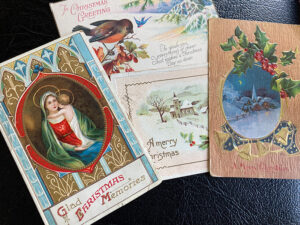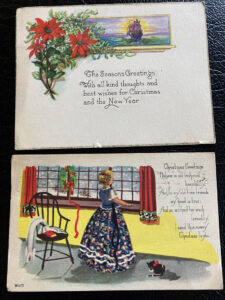Season’s Greetings
By Michele Bazan Reed

We’re coming into my favorite season. Oh sure, I love a Central New York fall with its crunchy apples, brilliant leaves, sweater weather and pumpkin spice everything. But I was specifically thinking of … greeting card season!
The advertisements start coming back in August — catalogs from the Metropolitan Museum, Art Institute of Chicago, UNICEF, all ready to tempt me with the most beautiful Christmas cards. I eagerly browse the beautiful artwork and inspiring messages. Renaissance Madonnas, modern art Christmas trees and stylized doves beguile me. I’d buy them all if I could.
But why stop there? There’s a whole big season of card-sending ahead. Halloween, Thanksgiving, New Year’s and Valentine’s Day call for personal notes on clever cards. Then there’s Easter on the horizon, and all the months sprinkled with birthdays, graduations, weddings and new babies.
There are those who long ago predicted the demise of greeting cards. Why, if you can instantly send an email to wish someone Happy Birthday or post your greetings on their Facebook page, would you bother to handwrite a card, apply a stamp and head out to the post office or a letterbox to mail it? The rise of animated e-cards with music and dancing animals or interactive games caused the Cassandras to bemoan the sorry future of paper-and-ink greetings.
But a funny thing happened on the way to greeting card oblivion. As Marshall McLuhan said, “The medium is the message.” People still clung to the personal touch: a greeting handwritten by a friend, on a card they hand-picked with the recipient in mind, and the obvious time and effort it took to choose, sign, address and mail it was still a cherished thing.
Statistics compiled in 2019 by the Greeting Card Association show that Americans routinely purchase about 6.5 billion greeting cards per year, and spend between $7 billion and $8 billion on them. And while it’s true we baby boomers buy the most cards, millennials spend the most on them. It seems the younger generation, they who grew up emailing and texting one another from childhood, somehow along the way discovered the joys of a handwritten greeting.
Maybe it’s all the thank-you notes we forced them to write as children, or maybe they discovered for themselves that the online world is fleeting. Texts and e-greetings are free and have the benefit of immediacy, but it’s just not the same as a paper greeting you can hold in your hand, pin up over your desk, or tuck in a book to reread whenever you need something to cheer you up.
The tradition of exchanging holiday greetings dates all the way back to ancient new year’s wishes shared by Chinese, Egyptian and Roman people. The modern paper greeting card craze started in the mid-19th century with postcards, made plentiful and affordable due to innovations in printing.
Traditions vary widely across the globe. I know when Bill and I were in France, they don’t routinely send Christmas cards. It’s possible to get Christmas cards wishing Joyeux Noel if you really hunt them down, but for the most part, the French send New Year’s greetings with cards much like our own Christmas cards and neighbors wish each other Bonne Année throughout the month of January.
There’s a great divide between those who keep cards and those who dispose of them once read. Many people I know keep their Christmas cards all season, hanging them on mantelpieces or banisters, or covering an interior door with rows of greetings from family and friends. But often they discard other cards after the occasion for their arrival has passed.
 I have one cousin who sends carefully chosen greetings for every occasion, even St. Patrick’s Day. She expressed horror that a friend of hers admitted tossing greeting cards shortly after receiving them. I’m sure she thought of the time she spent meticulously choosing the right image and verse, not to mention the cost of cards, which averages from $3 to $5 now and can climb as high as $8 or $10 for pop-up or musical versions, or handmade creations with intricately cut or painted designs.
I have one cousin who sends carefully chosen greetings for every occasion, even St. Patrick’s Day. She expressed horror that a friend of hers admitted tossing greeting cards shortly after receiving them. I’m sure she thought of the time she spent meticulously choosing the right image and verse, not to mention the cost of cards, which averages from $3 to $5 now and can climb as high as $8 or $10 for pop-up or musical versions, or handmade creations with intricately cut or painted designs.
Earlier generations saved cards. Perhaps the expense had something to do with it, or the tangible connection with loved ones far away. Thanks to them, we have many examples to hunt down and enjoy.
Over the years, prowling around in antique shops and flea markets, I collected many of these postcard greetings, with rhyming verses, pink-cheeked children and illustrations alternately humorous and ornate. They marked the birthdays and holidays of people long dead. I loved decorating with them for the various holidays. Reading the messages inscribed on the back always seemed a little like eavesdropping, but I enjoyed it nonetheless, imagining the writers and the recipients, and weaving narratives of my own out of the cryptic snippets of message.
So in this, my favorite season, I’ll carry on the tradition of those Victorian-age correspondents. I’ll shop for the funniest, or most heartfelt, or truly beautiful cards to express my wishes to friends and family at the upcoming holidays. And maybe, if the cards survive, someone a hundred years from now, poking through a 22nd-century equivalent of an antique shop, may find my good wishes and marvel at the old-fashioned greetings.

